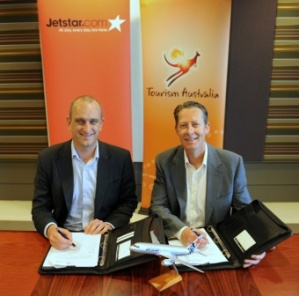Tourism Australia has signed a $10 million marketing deal with Jetstar aimed at boosting Japanese inbound tourism and further expanding brand Australia’s presence in Asia Pacific.
The three year agreement runs to mid 2014 and will see Tourism Australia and Jetstar each contribute at least $1.6 million per year on a range of joint marketing, digital and social media activities.

As a part of the deal, Tourism Australia and Jetstar will work cooperatively to leverage more affordable air travel and Australia’s unique attractions to increase arrivals from Japan, China, Indonesia, Malaysia, Singapore and New Zealand.
The first tranche of $2 million will be directed to rejuvenating the Japanese market, which has slipped from Australia’s second to fifth largest source market for international tourists over the past ten years.
Managing director Andrew McEvoy said the deal was an extension of Tourism Australia’s ongoing focus on Asia but also represented a new approach to Japan and working with airlines partners.
“It unlocks real value by leveraging the combined skills, expertise and resources which both our organizations have long demonstrated in Asia. We aim to use our well-established and successful There’s nothing like Australia campaign messaging alongside Jetstar.com to drive bookings and inbound travel,” he said.
“Jetstar broke the mould in the Japan market with the launch of their low fare operations to Australia in 2007, which stimulated a new generation of travellers to visit Australia. With Jetstar Japan launching domestic services within the world’s third largest economy in 2012, Australia will become more accessible than ever to holidaymakers from some of Japan’s key cities.
“Like Tourism Australia, Jetstar has ambitious expansion plans for wider Asia and sees sustained and large growth opportunities, led by the greater China market, and numerable South East and North Asian markets including Japan, which will clearly remain in the top half dozen of Australia’s tourism export markets. There’s strong alignment and a real natural fit.”
Tourism Australia has now secured long-term cooperative marketing relationships with most of the largest international carriers by capacity serving Australia.
“Our global campaign, There’s nothing like Australia, is travelling very well in Asia, with growing levels of marketing activity carried out in partnership with airlines to extend our reach and impact to the Asian consumer,” said McEvoy.
Jetstar Group CEO Bruce Buchanan said the expansion of Jetstar’s low fares network across Asia had the ability to stimulate fresh demand by putting air travel to key Australian leisure destinations within reach for many more people.
“Jetstar is now the largest low cost airline in the Asia Pacific by revenue and we’re recognized as a top 100 brand in Japan even before launching our domestic airline there,” said Buchanan.
“This partnership will leverage Australia’s attractiveness as a destination for international tourists with Jetstar’s leading low fares as a means to convert this into actual arrivals. The potential flow-on benefits for Australian tourism will be significant.”
McEvoy said markets covered by this agreement are critical to us achieving Australian tourism’s year 2020 goal of doubling overnight visitor expenditure to A$140 billion.
“This new strategic alliance will be a hugely important platform from which to take our marketing message further into Asia, and on the back of significant increases in aviation capacity,” said McEvoy.
Japan is currently Australia’s fifth largest source market for international tourists, spending approximately $1.5 billion in 2010. There were 350,200 visitor arrivals from Japan for the twelve months ending August 2011, a drop of 11 per cent.
Tourism Australia believes this market has the potential to grow to between A$2.7 billion and A$3.3 billion in total expenditure by 2020.

